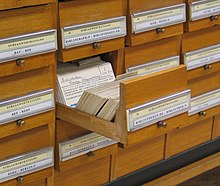
Back بيانات وصفية Arabic Metaməlumatlar Azerbaijani Метаданни Bulgarian Metadades Catalan Metadata Czech Metadata Welsh Metadata Danish Metadaten German Μεταδεδομένα Greek Meta-dateno Esperanto



Metadata (or metainformation) is "data that provides information about other data",[1] but not the content of the data itself, such as the text of a message or the image itself.[2] There are many distinct types of metadata, including:
- Descriptive metadata – the descriptive information about a resource. It is used for discovery and identification. It includes elements such as title, abstract, author, and keywords.
- Structural metadata – metadata about containers of data and indicates how compound objects are put together, for example, how pages are ordered to form chapters. It describes the types, versions, relationships, and other characteristics of digital materials.[3]
- Administrative metadata[4] – the information to help manage a resource, like resource type, and permissions, and when and how it was created.[5]
- Reference metadata – the information about the contents and quality of statistical data.
- Statistical metadata[6] – also called process data, may describe processes that collect, process, or produce statistical data.[7]
- Legal metadata – provides information about the creator, copyright holder, and public licensing, if provided.
Metadata is not strictly bound to one of these categories, as it can describe a piece of data in many other ways.
- ^ "Merriam Webster". Archived from the original on 27 February 2015. Retrieved 17 October 2019.
- ^ Gonzalez-Perez C (2018). "Metainformation". In Gonzalez-Perez C (ed.). Information modelling for archaeology and anthropology: software engineering principles for cultural heritage (1st ed.). Springer Cham. pp. 181–189. ISBN 978-3-319-72652-6.
- ^ "An Architecture for Information in Digital Libraries". Archived from the original on 27 March 2017. Retrieved 10 May 2017.
- ^ Zeng, Marcia (2004). "Metadata Types and Functions". NISO. Archived from the original on 7 October 2016. Retrieved 5 October 2016.
- ^ National Information Standards Organization (NISO) (2001). Understanding Metadata (PDF). NISO Press. p. 1. ISBN 978-1-880124-62-8. Archived from the original (PDF) on 7 November 2014. Retrieved 20 June 2008.
- ^ Directorate, OECD Statistics. "OECD Glossary of Statistical Terms – Reference metadata Definition". stats.oecd.org. Archived from the original on 11 July 2021. Retrieved 24 May 2018.
- ^ Dippo, Cathryn; Sundgren, Bo. "The Role of Metadata in Statistics" (PDF). Bureau of Labor Statistics. Archived (PDF) from the original on 14 July 2021. Retrieved 3 February 2021.